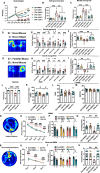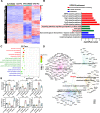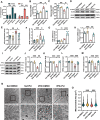Puerarin attenuates valproate-induced features of ASD in male mice via regulating Slc7a11-dependent ferroptosis
- PMID: 37491673
- PMCID: PMC10789763
- DOI: 10.1038/s41386-023-01659-4
Puerarin attenuates valproate-induced features of ASD in male mice via regulating Slc7a11-dependent ferroptosis
Abstract
Autism spectrum disorder (ASD) is a complicated, neurodevelopmental disorder characterized by social deficits and stereotyped behaviors. Accumulating evidence suggests that ferroptosis is involved in the development of ASD, but the underlying mechanism remains elusive. Puerarin has an anti-ferroptosis function. Here, we found that the administration of puerarin from P12 to P15 ameliorated the autism-associated behaviors in the VPA-exposed male mouse model of autism by inhibiting ferroptosis in neural stem cells of the hippocampus. We highlight the role of ferroptosis in the hippocampus neurogenesis and confirm that puerarin treatment inhibited iron overload, lipid peroxidation accumulation, and mitochondrial dysfunction, as well as enhanced the expression of ferroptosis inhibitory proteins, including Nrf2, GPX4, Slc7a11, and FTH1 in the hippocampus of VPA mouse model of autism. In addition, we confirmed that inhibition of xCT/Slc7a11-mediated ferroptosis occurring in the hippocampus is closely related to puerarin-exerted therapeutic effects. In conclusion, our study suggests that puerarin targets core symptoms and hippocampal neurogenesis reduction through ferroptosis inhibition, which might be a potential drug for autism intervention.
© 2023. The Author(s), under exclusive licence to American College of Neuropsychopharmacology.
Conflict of interest statement
The authors declare no competing interests.
Figures





References
MeSH terms
Substances
LinkOut - more resources
Full Text Sources
Medical
Miscellaneous

